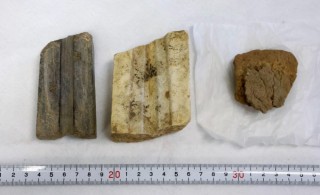Loading
Search
▼ Japan's Possibly Oldest Molds For Bronze Relics Found At Saga Ruins
- Category:Other
Relics including stone casting molds for bronze artifacts, potentially the oldest of their kind in Japan, have been discovered at an archaeological site in the western prefecture of Saga, the prefectural government said Monday.
One of the molds could date back to around 200 BC, according to the local government. The discoveries between September and October at the Yoshinogari ruins followed the finding in April of a stone coffin tomb believed to have belonged to a person of high status in an area of the site.
The enigmatic coffin prompted experts and archaeology buffs to wonder whose burial site it is, a question that might cause a stir in a long-standing dispute over where the nation's ancient Yamatai kingdom was located.
But it was announced in June that no human bones or burial accessories were found that could yield clues as to the individual's identity or the exact period of burial.
The latest excavation of what is called the "mystery area," which could not be surveyed because a shrine had been there, found three items -- casting molds made of serpentinite and quartz-porphyry, as well as a clay vessel used as a container for molten metal -- made in the Yayoi period of Japanese history.
The molds, possibly used for casting swords and spears, were found within a range of about 5 meters northwest to about 10 meters south-southwest from where the stone coffin was discovered, according to the prefecture.
"It is an extremely significant discovery in understanding distinct features of the structure (of ruins) and the changes," a prefectural official said.
Serpentinite preceded quartz-porphyry as stone mold in general, said Chuhei Takashima, an archaeologist with expertise in the Yoshinogari ruins, adding that the technology could have directly derived from the Korean Peninsula.
The discoveries "added further meaning to Yoshinogari, which was a manufacturing site of bronze artifacts in Japan, introducing the most advanced technology back then," Takashima said.
The ruins were designated as a national historic site in 1991 and are currently open to the public as the Yoshinogari Historical Park.
- December 4, 2023
- Comment (0)
- Trackback(0)


